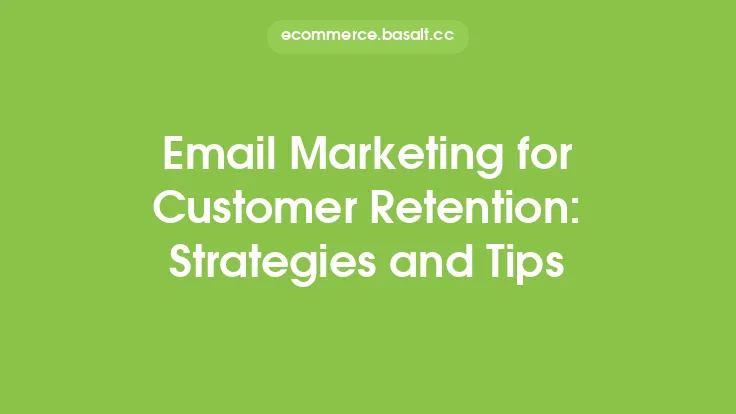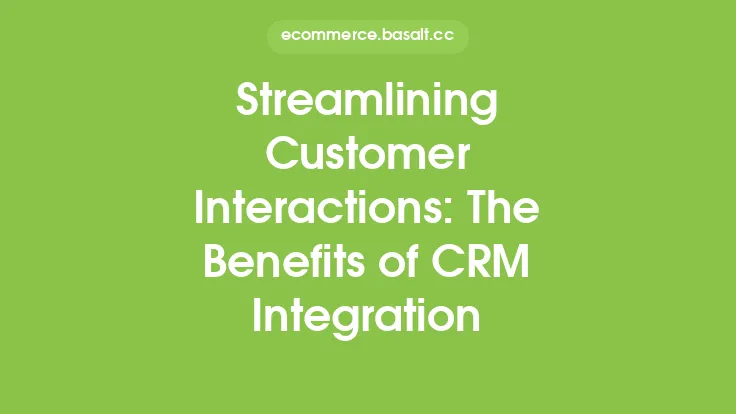In today's competitive e-commerce landscape, businesses are constantly seeking ways to stay ahead of the curve and maintain a loyal customer base. One crucial aspect of achieving this goal is through the effective implementation of Customer Relationship Management (CRM) systems. CRM is a strategic approach that focuses on building and maintaining long-term relationships with customers, and it plays a vital role in driving customer loyalty and retention. By leveraging CRM, businesses can gain a deeper understanding of their customers' needs, preferences, and behaviors, enabling them to deliver personalized experiences that foster loyalty and encourage repeat business.
Introduction to Customer Loyalty and Retention
Customer loyalty and retention are critical components of any successful e-commerce business. Loyal customers are more likely to return to a website, make repeat purchases, and recommend the brand to others, resulting in increased revenue and growth. However, acquiring new customers can be a costly and time-consuming process, making it essential for businesses to focus on retaining existing customers. CRM systems provide a comprehensive platform for managing customer interactions, analyzing customer data, and developing targeted marketing strategies to promote loyalty and retention.
The Role of CRM in Customer Loyalty and Retention
CRM systems play a pivotal role in driving customer loyalty and retention by providing businesses with a centralized platform to manage customer interactions, track customer behavior, and analyze customer data. With CRM, businesses can gain a deeper understanding of their customers' needs, preferences, and pain points, enabling them to deliver personalized experiences that meet their expectations. CRM also enables businesses to respond promptly to customer inquiries, resolve issues efficiently, and provide timely support, resulting in increased customer satisfaction and loyalty.
Key Features of CRM Systems for Customer Loyalty and Retention
Effective CRM systems for customer loyalty and retention typically include a range of features, such as contact management, sales management, marketing automation, and customer service and support. Contact management enables businesses to store and manage customer contact information, interaction history, and preferences, providing a comprehensive view of each customer. Sales management features help businesses to track sales performance, manage leads, and analyze sales data, enabling them to identify opportunities to upsell and cross-sell. Marketing automation features allow businesses to develop targeted marketing campaigns, automate email marketing, and personalize customer communications, resulting in increased engagement and conversion.
Benefits of Using CRM for Customer Loyalty and Retention
The benefits of using CRM for customer loyalty and retention are numerous. By implementing a CRM system, businesses can increase customer satisfaction, loyalty, and retention, resulting in increased revenue and growth. CRM also enables businesses to gain a deeper understanding of their customers' needs and preferences, enabling them to deliver personalized experiences that meet their expectations. Additionally, CRM provides businesses with a centralized platform to manage customer interactions, track customer behavior, and analyze customer data, resulting in increased efficiency and productivity.
Best Practices for Implementing CRM for Customer Loyalty and Retention
To get the most out of a CRM system for customer loyalty and retention, businesses should follow best practices, such as defining clear goals and objectives, developing a comprehensive customer engagement strategy, and providing ongoing training and support to employees. Businesses should also ensure that their CRM system is integrated with other business systems, such as sales, marketing, and customer service, to provide a seamless and personalized customer experience. Additionally, businesses should regularly review and analyze customer data to identify opportunities to improve customer loyalty and retention.
Common Challenges and Limitations of CRM for Customer Loyalty and Retention
While CRM systems can be highly effective in driving customer loyalty and retention, there are common challenges and limitations that businesses should be aware of. One of the main challenges is data quality, as inaccurate or incomplete customer data can result in ineffective marketing campaigns and poor customer experiences. Another challenge is user adoption, as employees may resist using a new CRM system or may not have the necessary skills to use it effectively. Businesses should also be aware of the potential for CRM systems to become overly complex, resulting in increased costs and decreased productivity.
Future of CRM for Customer Loyalty and Retention
The future of CRM for customer loyalty and retention is exciting and rapidly evolving. With the increasing use of artificial intelligence, machine learning, and the Internet of Things (IoT), CRM systems are becoming more sophisticated and personalized. Businesses are using CRM systems to analyze customer data, predict customer behavior, and deliver highly personalized experiences that meet their needs and preferences. Additionally, the use of mobile devices and social media is changing the way businesses interact with customers, and CRM systems are adapting to these changes by providing mobile and social media integration.
Conclusion
In conclusion, CRM systems play a vital role in driving customer loyalty and retention in the e-commerce industry. By providing a comprehensive platform for managing customer interactions, analyzing customer data, and developing targeted marketing strategies, CRM systems enable businesses to deliver personalized experiences that foster loyalty and encourage repeat business. As the e-commerce landscape continues to evolve, businesses must stay ahead of the curve by leveraging the latest CRM technologies and strategies to drive customer loyalty and retention. By doing so, businesses can increase customer satisfaction, loyalty, and retention, resulting in increased revenue and growth.





